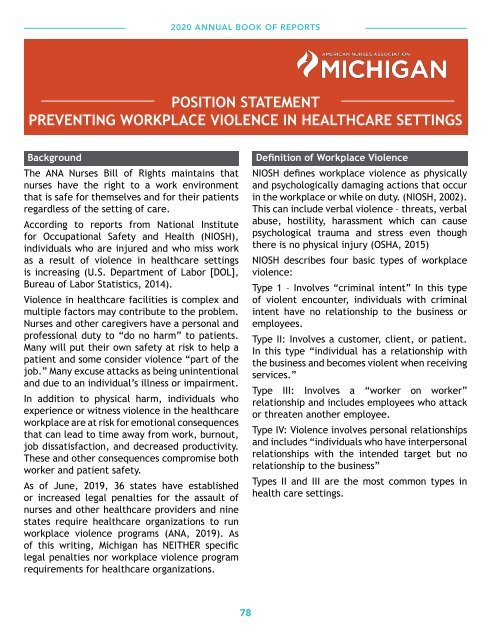ANA-Michigan - 2020 Annual Book of Reports
Create successful ePaper yourself
Turn your PDF publications into a flip-book with our unique Google optimized e-Paper software.
<strong>2020</strong> ANNUAL BOOK OF REPORTS<br />
POSITION STATEMENT<br />
PREVENTING WORKPLACE VIOLENCE IN HEALTHCARE SETTINGS<br />
Background<br />
The <strong>ANA</strong> Nurses Bill <strong>of</strong> Rights maintains that<br />
nurses have the right to a work environment<br />
that is safe for themselves and for their patients<br />
regardless <strong>of</strong> the setting <strong>of</strong> care.<br />
According to reports from National Institute<br />
for Occupational Safety and Health (NIOSH),<br />
individuals who are injured and who miss work<br />
as a result <strong>of</strong> violence in healthcare settings<br />
is increasing (U.S. Department <strong>of</strong> Labor [DOL],<br />
Bureau <strong>of</strong> Labor Statistics, 2014).<br />
Violence in healthcare facilities is complex and<br />
multiple factors may contribute to the problem.<br />
Nurses and other caregivers have a personal and<br />
pr<strong>of</strong>essional duty to “do no harm” to patients.<br />
Many will put their own safety at risk to help a<br />
patient and some consider violence “part <strong>of</strong> the<br />
job.” Many excuse attacks as being unintentional<br />
and due to an individual’s illness or impairment.<br />
In addition to physical harm, individuals who<br />
experience or witness violence in the healthcare<br />
workplace are at risk for emotional consequences<br />
that can lead to time away from work, burnout,<br />
job dissatisfaction, and decreased productivity.<br />
These and other consequences compromise both<br />
worker and patient safety.<br />
As <strong>of</strong> June, 2019, 36 states have established<br />
or increased legal penalties for the assault <strong>of</strong><br />
nurses and other healthcare providers and nine<br />
states require healthcare organizations to run<br />
workplace violence programs (<strong>ANA</strong>, 2019). As<br />
<strong>of</strong> this writing, <strong>Michigan</strong> has NEITHER specific<br />
legal penalties nor workplace violence program<br />
requirements for healthcare organizations.<br />
Definition <strong>of</strong> Workplace Violence<br />
NIOSH defines workplace violence as physically<br />
and psychologically damaging actions that occur<br />
in the workplace or while on duty. (NIOSH, 2002).<br />
This can include verbal violence – threats, verbal<br />
abuse, hostility, harassment which can cause<br />
psychological trauma and stress even though<br />
there is no physical injury (OSHA, 2015)<br />
NIOSH describes four basic types <strong>of</strong> workplace<br />
violence:<br />
Type 1 – Involves “criminal intent” In this type<br />
<strong>of</strong> violent encounter, individuals with criminal<br />
intent have no relationship to the business or<br />
employees.<br />
Type II: Involves a customer, client, or patient.<br />
In this type “individual has a relationship with<br />
the business and becomes violent when receiving<br />
services.”<br />
Type III: Involves a “worker on worker”<br />
relationship and includes employees who attack<br />
or threaten another employee.<br />
Type IV: Violence involves personal relationships<br />
and includes “individuals who have interpersonal<br />
relationships with the intended target but no<br />
relationship to the business”<br />
Types II and III are the most common types in<br />
health care settings.<br />
78

















